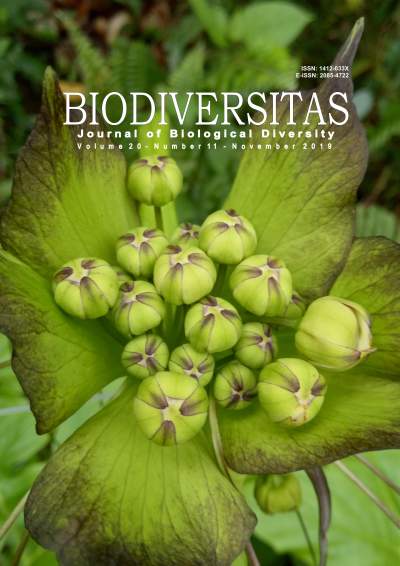Hydrocarbon degradation by bacteria from rhizospheres of Imperata cylindrica at oil mining site in Wonocolo, Bojonegoro, Indonesia
##plugins.themes.bootstrap3.article.main##
Abstract
Abstract. Sari MA, Retnaningrum E. 2019. Hydrocarbon degradation by bacteria from rhizospheres of Imperata cylindrica at oil mining site in Wonocolo, Bojonegoro, Indonesia. Biodiversitas 20: 3422-3429. High oil mining activities cause environmental pollution at the oil mining site. Petroleum spills and waste to the river flow cause blackish discoloration along the riverbank and also some types of plants die. The utilization of rhizospheric bacteria (rhizobacteria) as a bioremediation agent is considered as appropriate for reducing petroleum contaminants. The purposes of this study were to analyze the ability of hydrocarbon degradation by selected rhizobacteria isolates, to identify molecularly and analyze the genetic relationship of hydrocarbon-degrading rhizobacteria based on 16S rRNA gene sequencing. The rhizobacteria of cogongrass (Imperata cylindrica L.) were isolated from oil mining site in Wonocolo, Kedewan, Bojonegoro, East Java, Indonesia. The 5 isolates of rhizobacteria were then cultured on Bushnell-Haas Mineral Salt (BHMS) medium with the addition of 0.015% crude oil for analyzing their growth based on their cell densities using the Total Plate Count method. The optimal rhizobacteria growth obtained (MTMW2 isolate) was selected and further analysed its ability for hydrocarbon degradation through measuring of Total Petroleum Hydrocarbon (TPH). Its rhizobacteria were then identified using 16S rRNA gene sequencing. The MTMW2 isolate revealed specific growth rate of 0.14 in BHMS medium with the addition of 0.015% crude oil. After 10 days of incubation, the isolates could degrade Total Petroleum Hydrocarbon in the medium as much as 96.1%. The results of molecular identification and phylogenetic tree construction showed that MTMW2 isolate was identified as Pseudomonas aeruginosa.
